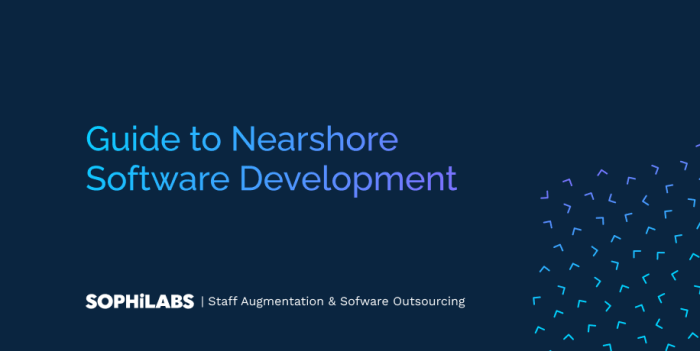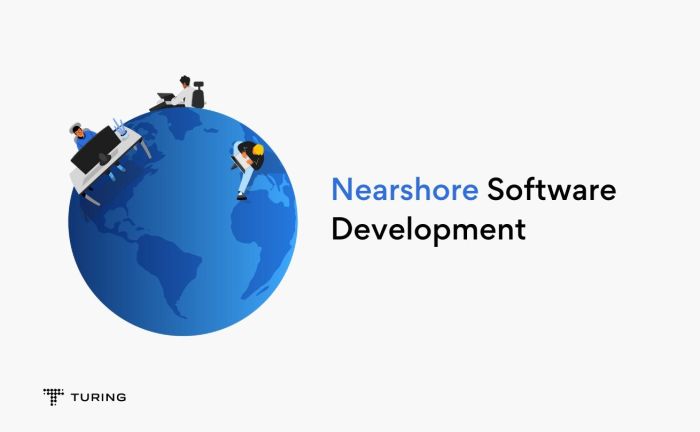In today’s rapidly evolving digital landscape, mobile applications are no longer a luxury but a necessity for businesses of all sizes. Developing a high-quality mobile app, however, requires significant investment in time, resources, and expertise. This is where nearshore software development emerges as a compelling solution, offering a compelling blend of cost-effectiveness, proximity, and cultural understanding.

Understanding Nearshore Software Development
Nearshore software development refers to outsourcing software development projects to a country geographically close to your own. Unlike offshore outsourcing, which involves working with teams in distant locations (like India or the Philippines), nearshore outsourcing leverages the expertise of developers in neighboring countries or regions. This proximity offers several key advantages, including reduced time zone differences, easier communication, and simpler travel logistics. For companies based in the United States, this often means partnering with development teams in Mexico, Central America, or Canada.
Benefits of Choosing Nearshore Development for Mobile Apps
- Cost-Effectiveness: While still offering significant cost savings compared to in-house development, nearshore development often provides a more favorable price point than offshore options due to lower overhead and potentially higher skill levels for a given cost.
- Improved Communication and Collaboration: Reduced time zone differences facilitate real-time communication and collaboration, leading to faster project turnaround times and better problem-solving. This also contributes to better project management.
- Cultural Understanding and Alignment: Nearshore partners often share similar cultural values and business practices, resulting in smoother project management and fewer misunderstandings. This cultural proximity can lead to more effective communication and stronger working relationships.
- Easier Travel and On-site Collaboration: The geographical proximity allows for easier and more cost-effective travel for meetings, workshops, and on-site collaboration, fostering stronger relationships and improving project oversight.
- Access to Specialized Skills: Nearshore regions often boast a growing pool of talented software developers with expertise in various technologies, including iOS, Android, React Native, Flutter, and other mobile app development frameworks.
- Stronger Intellectual Property Protection: Working with a nearshore partner within a similar legal and regulatory framework can offer enhanced protection of intellectual property compared to some offshore locations.
Choosing the Right Nearshore Partner for Your Mobile App
Selecting the right nearshore software development partner is crucial for the success of your mobile app project. Consider these factors:

Key Considerations When Selecting a Nearshore Partner:
- Technical Expertise and Experience: Assess the partner’s portfolio, looking for relevant experience in mobile app development, specifically in the technologies you’re using (e.g., Swift, Kotlin, React Native). Look for evidence of successful project delivery and client testimonials.
- Communication and Collaboration Capabilities: Evaluate their communication processes and tools. Effective communication is paramount, so ensure they are proficient in your preferred language and use collaboration platforms you’re comfortable with (e.g., Slack, Jira).
- Project Management Methodology: Understand their project management approach (e.g., Agile, Waterfall). Ensure it aligns with your project requirements and expectations. Transparency and regular progress updates are essential.
- Security and Data Protection: Inquire about their security protocols and data protection measures. Verify they comply with relevant regulations and industry best practices to safeguard your sensitive information.
- Legal and Contractual Agreements: Thoroughly review the contract, including intellectual property rights, payment terms, and dispute resolution mechanisms. Seek legal counsel if needed.
- Company Culture and Values: Assess the company’s culture and values to ensure alignment with your own. A strong cultural fit can significantly contribute to a successful partnership.
Nearshore Development Models for Mobile Apps
Several models facilitate nearshore collaboration. Understanding these models helps in selecting the best fit for your project.
Popular Nearshore Development Models:
- Dedicated Team: A dedicated team of developers works exclusively on your project, offering consistent collaboration and focused expertise.
- Project-Based Outsourcing: A team is assembled for a specific project with a defined scope and timeline. This is suitable for smaller projects with clear deliverables.
- Staff Augmentation: Supplementing your in-house team with nearshore developers for specific skills or expertise gaps. This provides flexibility and scalability.
Technologies Used in Nearshore Mobile App Development
Nearshore developers are proficient in a wide range of technologies for mobile app development. Some of the most popular include:
Popular Mobile App Development Technologies:
- Native Development (iOS and Android): Building apps specifically for each platform (Swift/Objective-C for iOS and Kotlin/Java for Android) offers optimal performance and access to platform-specific features.
- Cross-Platform Development (React Native, Flutter, Xamarin): Using a single codebase to build apps for multiple platforms, reducing development time and cost. This approach offers a balance between performance and development speed.
- Hybrid Development (Ionic, Cordova): Combining web technologies (HTML, CSS, JavaScript) with native components to create apps. This is often the most cost-effective option but might compromise performance.
Addressing Common Concerns about Nearshore Development
Some companies hesitate to embrace nearshore development due to concerns about communication, quality, and security. Addressing these concerns proactively can alleviate anxieties.
Nearshore software development offers a compelling alternative for mobile app projects, providing a balance between cost-effectiveness and ease of communication. However, for projects requiring a larger pool of specialized talent, exploring options like those offered by offshore software development teams can be beneficial. Ultimately, the best approach for nearshore mobile app development depends on the specific needs and resources of each project.

Addressing Common Concerns:
- Communication Barriers: Choose a partner with excellent English proficiency and utilize effective communication tools and strategies to minimize misunderstandings.
- Quality Control: Establish clear quality assurance processes and metrics from the outset. Regular code reviews, testing, and feedback mechanisms are crucial.
- Security Risks: Select a partner with robust security protocols and data protection measures in place. Ensure compliance with relevant regulations and industry best practices.
Frequently Asked Questions (FAQ)
- Q: What are the main differences between nearshore and offshore development?
A: Nearshore development involves outsourcing to a geographically closer country, offering advantages in communication, time zone alignment, and travel logistics. Offshore development involves outsourcing to a distant country, often resulting in lower costs but potentially increased communication challenges. - Q: How can I ensure the quality of the mobile app developed nearshore?
A: Implement robust quality assurance processes, including regular code reviews, testing, and feedback mechanisms. Choose a partner with a proven track record and clear quality control procedures. - Q: What are the typical costs associated with nearshore mobile app development?
A: Costs vary depending on factors such as project complexity, team size, and location. However, nearshore development generally offers a more cost-effective solution compared to in-house development, while still maintaining a higher level of communication and control compared to offshore development. - Q: How can I protect my intellectual property when working with a nearshore partner?
A: Ensure your contract includes strong intellectual property protection clauses. Choose a reputable partner with a proven track record of protecting client information and a clear understanding of intellectual property rights.
Conclusion
Nearshore software development offers a compelling solution for businesses seeking to develop high-quality mobile applications efficiently and cost-effectively. By carefully selecting a reputable partner and implementing robust project management practices, companies can leverage the benefits of proximity, cultural understanding, and skilled talent to achieve their mobile app development goals.
Ready to explore the benefits of nearshore mobile app development? Contact us today for a consultation!
